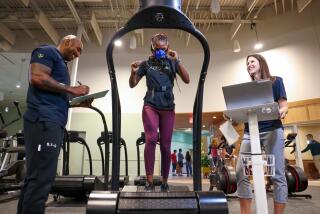SOUTHERN CALIFORNIA JOB MARKET : PART THREE: EXTRAS THAT COUNT : Working Out at Work : Fitness Programs Boost Morale, Shape Up Corporate Bottom Lines--And More
- Share via
Forget lean and mean. They may be 1990s watchwords for U.S. corporate strategy, but in terms of fitness they’ve gone the way of Charles Atlas and raw steak diets. Think, instead, of cardiovascular health and destressing. Or increased energy and higher productivity. Or reduced absenteeism and improved morale.
These are some of the benefits companies experience with their in-house fitness and recreation programs. And healthier, happier employees make for a better bottom line.
How much better? At a Safeway Stores bakery in Clackamas, Ore., plant manager Bob Jacobson estimates that the wide-ranging program initiated at his work site saves the company $700,000 to $800,000 a year in reduced tardiness, absenteeism, damage to equipment, industrial grievances and turnover. The plant employs about 180 people.
A study done at Adolph Coors Co. in Golden, Colo., found that for every dollar invested in the Coors Wellness program, the brewing company may gain from $1.44 to $8.33 in savings on health-care costs, sick leave, turnover costs and increased productivity, according to the National Employee Services and Recreation Assn., a Westchester, Ill.-based trade group.
“The work site has the opportunity to be the positive place in a person’s life,” Jacobson says. “Wellness starts with attitude and self-esteem. We wanted the work site to be the place where (employees) feel someone cares, where someone says, ‘You’re important.’ ”
When the company first decided to start a workout program, Jacobson says, it looked at what was available in the community. The problem, he says, was that at local gyms, the staffs were relatively uneducated about fitness training and the operations were geared to a 9-to-5 society, while his plant runs 24 hours a day. So employees built their own gym.
Volunteers turned an old supply room into a fitness facility, Jacobson says. “All the fitness equipment was built by employees in their garages.”
The plant’s 12-year-old program also includes instruction in martial arts and communications, and even a humor class where “adults learn that it’s OK to play.” Jacobson says the programs touch 90% of the employees in some form. “We’re improving the quality of life for people.”
At Tenneco Oil Co. in Houston, Bill Baun, manager of the firm’s health and fitness program, says peer support is an important factor at a company gym.
“They set goals and objectives on their jobs and they can get that same support in losing weight or lowering their blood pressure,” he says.
From 37% to 45% of the 1,900 employees at Tenneco’s Houston headquarters use the company’s 25,000-square-foot fitness center. Baun says it is used by employees at all levels too.
“I open up on Tuesday mornings and a senior vice president comes in at 5:30,” he says. “Right behind him comes someone who parks the cars.
“A single mother may have no other way to work out except at an on-site facility. For many, this facility is their only option.”
At Executive Life Insurance in Los Angeles, health promotion and fitness manager Michael Roberts says convenience is a big factor in the success of company fitness centers.
“Programs where the site is attached to the building have a much better utilization rate than facilities detached from the main building,” he says. Executive Life’s 3,500-square-foot gym is on the first floor. “We’re highly visible,” Roberts says.
Employees who use the facilities echo the gym managers. Company gyms are convenient. They offer more support and instruction than commercial gyms. And they build morale and team spirit.
“When you see a person sweating next to you, you get to know them in a whole different way,” says Rick Hollar, senior vice president and chief marketing officer for First Delaware Life, a subsidiary of Executive Life. “It does build camaraderie.
“It’s a real benefit not to have to join a gym,” says Hollar, who works out three to five times a week.
Computer instructor Sandy Saeta notes the convenience of the company gym. “My incentive is that I work in Santa Monica and I live in South Pasadena. I’d much rather be working out than sitting on the freeway and getting added stress from that.”
“It’s very convenient and cheaper (than a commercial gym),” says Helen Fitzgerald, 77, who uses the exercise bikes at Executive Life’s gym three times a week.
John McFarland, Executive Life’s human resources administrator, says: “If you’ve always wanted to get into a fitness program, having it right in your office really facilitates that. You don’t have to drive. There’s no excuse. You’ve got it here.”
McFarland notes that with the help of the gym, he’s lost 50 pounds in two years. “This is the first time I attempted to do it the way everyone says you should: exercise and eat right.”
The fact that companies employ knowledgeable fitness personnel helps too.
“Staff is important,” says Baun of Tenneco. “We have a coach and motivator who are there if you need a kick in the butt.”
At Executive Life, “the guys in the gym are real good about keeping you on the fitness program,” McFarland says. “If you get serious about lifting weights, they’re real willing to get involved. They show you the correct ways to work out. They can give you a lot of expertise you wouldn’t get somewhere else.”
And, of course, there are other motivations. “You really get to know people a lot better (at the gym),” McFarland says. “Not to mention you get to lose weight, get muscles and get a really buffed body.”
More to Read
Inside the business of entertainment
The Wide Shot brings you news, analysis and insights on everything from streaming wars to production — and what it all means for the future.
You may occasionally receive promotional content from the Los Angeles Times.










